Drinking Water Protection
- Drinking Water Protection Home
- About Us
- A-Z Index of Contaminants in Water
- Community Public Water Supply
- Drinking Water Grants and Loans
- Drinking Water Institute
- Drinking Water in Schools and Child Cares
- Drinking Water Revolving Fund
- Laws and Rules
- Noncommunity Public Water Supply
- Source Water Protection
- Water Operator and Certification Training
- Drinking Water Protection Contacts
Related Topics
- Annual Reports
- Drinking Water Risk Communication Toolkit
- Drinking Water Protection External Resources
- Fact Sheets
- Forms
- Invisible Heroes Videos: Minnesota's Drinking Water Providers
- Noncom Notes Newsletter
- Sample Collection Procedures (videos, pictures, written instructions)
- Waterline Newsletter
Related Sites
- 10 States Standards
- Clean Water Fund
- Health Risk Assessment – Guidance Values and Standards for Water
- Minnesota Well Index
- Water and Health
- Wells and Borings
Environmental Health Division
Waterline: Summer 2023

Editor:
Stew Thornley
Subscribe to The Waterline newsletter. An e-mail notice is sent out each quarter when a new edition is posted to the web site.
On this page:
- Gunilla Montgomery Dies
- Free Virtual Workshops Coming Up
- Anoka Water Keeps Up with City's Growth
- Lots of New Folks in Drinking Water Protection at MDH
- MDH Kiosk Debuts at MRWA Technical Conference
- Lead and Drinking Water Testing Program for School and Child Care Programs
- Lead Service Line Inventories Due October 16, 2024
- Quote of the Quarter
- Did You Know . . .
- Baseball Wisdom
- Calendar
Gunilla Montgomery dies
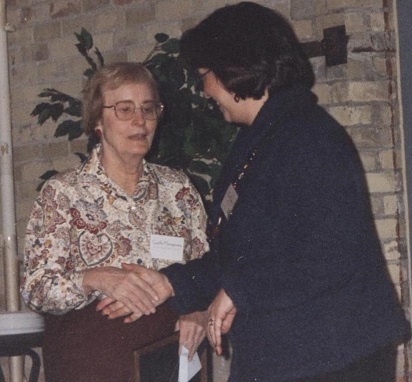
For many years Gunilla Montgomery was the face (and voice) of training for water operators, conducted by the Minnesota Department of Health (MDH) and the North Central/Minnesota Section of American Water Works Association.
Gunilla ran a tight ship and made sure operators were back in the classrooms on time, ringing a bell to emphasize that break time was over. Some practical jokers once glued the clapper of the bell to the inside, leaving it ringless. Undeterred, Gunilla used other means to get people back into the rooms.
Gunilla was born in Örnsköldsvik, Sweden, in 1930. She came to the United States to attend the Yale School of Medicine. Gunilla began her career at the Wisconsin Department of Natural Resources in 1973 and four years later came to MDH, where she worked until 2002, taking a two-year leave to work on water issues in Sri Lanka for the World Health Organization.
Even though it’s been more than 20 years since Gunilla retired, the mention of her name brings a smile to the old-timers who remember her.
Go to top
Free virtual workshops coming up
In conjunction with the Minnesota Department of Health (MDH), Minnesota Department of Natural Resources, and Minnesota Rural Water Association, the U. S. Environmental Protection Agency is presenting two virtual half-day workshops on drought preparedness and water loss for utilities.
Drought Preparedness will be held on Zoom from 8:30 to noon Central Time on Tuesday, June 6. Water Loss for Utilities will be at the same time on Wednesday, June 8.
The June 7 workshop will include a Minnesota drought system overview, information on federal funding for drought resilience, and strategies and solutions related to water conservation and efficiency.
June 8 will have an introduction to water loss and leak detection, case studies, and a look at the American Water Works Association (AWWA) water audit software, which can be downloaded at no cost: Free Water Audit Software.
The workshops are for drinking water and wastewater utility operators and managers, technical assistance providers, and local, state, and federal government agencies.
Minnesota water operators will earn 3.5 direct hours for each day of the workshop.
Go to top
Anoka water keeps up with city's growth
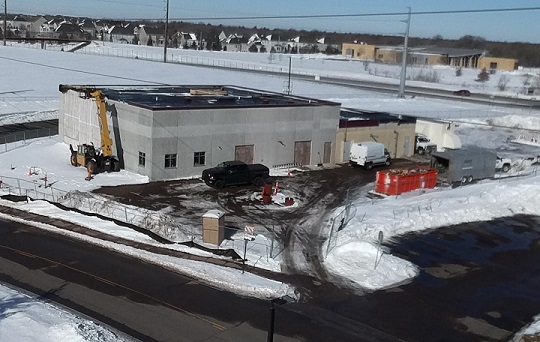
An aerial photo shows the increased height and footprint of the addition to the Anoka water treatment plant. Below is an interior look at the addition.
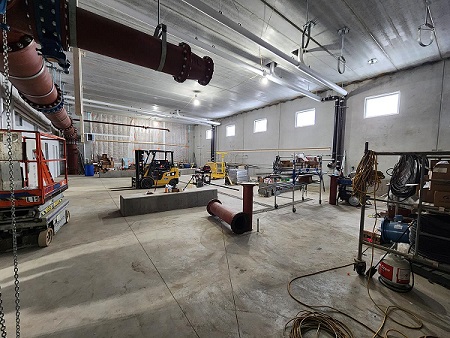
For decades Anoka was a free-standing city about 25 miles northwest of Minneapolis. The confluence of the Rum and Mississippi rivers brought pine logs, sawmills, and people to create a robust lumber industry, leading to the incorporation of Anoka in 1878.
Now part of the Twin Cities metropolitan area—partly by its own growth but more by the development of swelling suburbs between the cities—Anoka has a population of just over 17,000. It is known for tornadoes (the nickname of the city’s high school) and pumpkins (as the self-proclaimed Halloween capital of the world) as well as being the hometown of luminaries ranging from Briana Scurry to Garrison Keillor.
Anoka retains an independent nature distinct from its neighboring communities. “The unique thing is, it’s like being in a small town,” says Mark Anderson, Anoka’s director of public services. “Everybody knows everybody, but it’s still connected to the metro.”
Independent and self-sufficient, Anoka has had a public water system for more than a century, first using the Rum River as a source. A disease outbreak prompted the city to drill two wells and construct a building to house both water and electric operations. Remnants of the structure and wells still exist although Anoka has moved on to have four water treatment facilities to serve six wells. Ranging in depth from 274 to 657 feet and drawing from the Mt. Simon and Mt. Simon-Hinckley aquifers, the wells are in close proximity to the plants, which are spread out around the city.
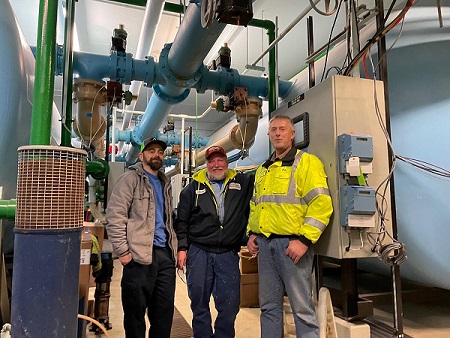
Marcus Mihelich, Donny Roseth, and Pete Klingenberg in front of the filters in the existing plant. Little space exists above the filters in the current plant.
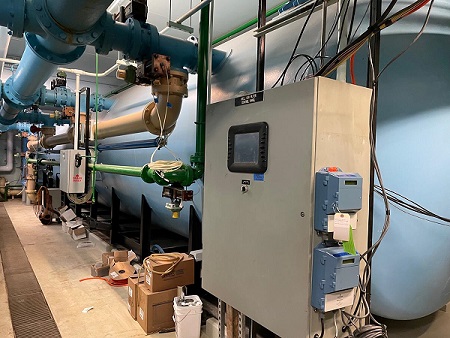
All of the water plants contain pressure filters, consisting of silica and anthracite, to remove iron and manganese as well as radium. Three of the wells have radium issues, and the city operated under a compliance agreement with the Minnesota Department of Health for a few years.
The radium in the water was reduced through co-precipitation with the addition of hydrous manganese oxide (HMO). “Radium is actually really easy to remove,” said John Thom of SEH, Inc., which has worked with the city on the issue. “Raise the manganese level in the effluent in the wells to the point that the radium will attach to the manganese. Then take that out.”
Blending is also used as a treatment technique, including at wells 6 and 8, which are within or near a treatment plant that is being expanded on the north side of the city, adjacent to Anoka High School and the municipal ice arena. In 2022, construction began for an expansion of this plant.
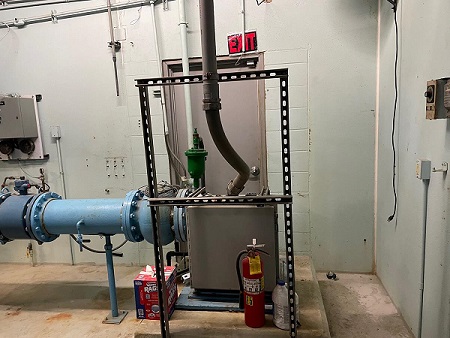
Well 5 inside the existing plant.
The project will entail two more pressure filters, doubling the plant’s capacity, as well as a laboratory, chemical-feed room, office, and a restroom (precluding the need for employees to make frequent visits to a nearby Casey’s store). In addition, the utility is switching from gas to liquid chlorine. “With the high school next door, it makes sense for safety reasons,” said water superintendent Pete Klingenberg.
While the number of filters is doubling, the structure size will be many times that. The footprint of the expansion is much larger than that of the existing plant, and the ceiling height will be greater. “That will make for easier maintenance,” said Donny Roseth, the facility’s main operator. “It’s pretty tight now. Not much extra room.”
“They should be commended for being pro-active and planning for the future,” said Minnesota Department of Health district engineer Brian Noma.
Financed through bonding, the $6.9 million expansion will feature other changes, including a change from pneumatic to electric valves, pumps, and a change from the effluent traveling down and out, under the building. “Now it will go up and out,” said Thom. “which makes it easier to tie in with the new filters.”
The new filters were installed in the spring of 2023 with completion expected by the end of the year.
“We’re going to increase our ability to treat water and meet all the growth that the city will see in the next 10 years,” said Anderson. “This will be our main plant. We still have a number of other wells, but this will do our heavy lifting.”
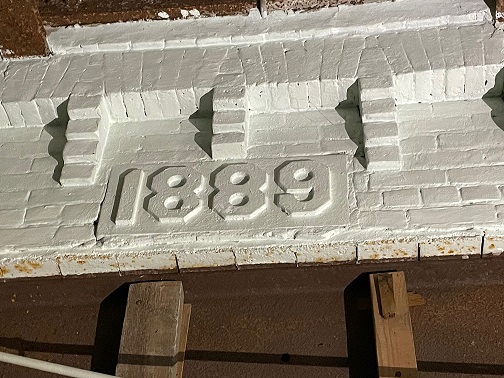
The original water treatment facility, opened in 1889, is now idle on the banks of the Rum River.
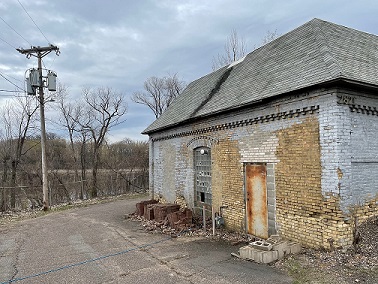
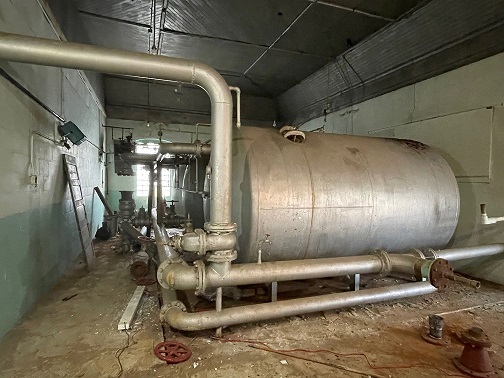
Pressure filters and the original well inside the now-idle plant.
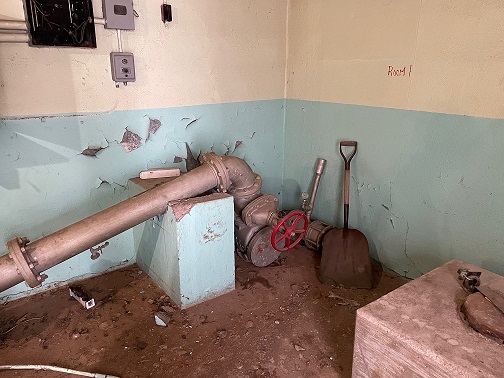
Go to top
Lots of new folks in Drinking Water Protection at MDH

Valerie Collins is a management analyst in the Administrative Unit of the MDH Drinking Water Protection Section. She grew up in Eagle River, Alaska, just north of Anchorage, and got her master’s degree in library science from Dalhousie University in Halifax, Nova Scotia.
Valerie has worked for the American Institute of Architects and spent the last seven years at the University of Minnesota Libraries, where she focused on research data management. Valerie enjoys reading and spending time outdoors. “I’m always out on a walk,” she says, “rain or shine.”
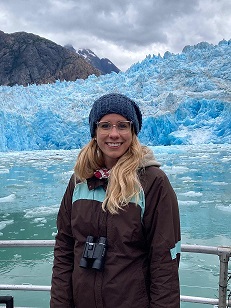
Caroline Olstad has joined the Minnesota Department of Health Drinking Water Protection Section (DWP) in the newly created position of lead in drinking water specialist. As part of the WIIN (Water Infrastructure Improvements for the Nation) Act grant from the U. S. Environmental Protection Agency to serve small and disadvantaged communities, Caroline will be providing outreach, education, and support with water testing and remediation activities primarily for schools and childcare centers.
Caroline grew up in Farmington but lived outside the state for six years while attending college and graduate school in Tacoma and St. Louis. She has previously worked in both blood and disaster services for the Epilepsy Foundation of Minnesota and the American Red Cross.
She loves to travel (the photo of her is in front of a glacier in Alaska) and has been to all seven continents.
Caroline now lives in Minneapolis with her fiancé, Jordan, and their Doberman-mix dog, Arlo. She welcomes contact (caroline.olstad@state.mn.us, 651-201-5317) from anyone with connections to schools, childcare providers, or Head Start programs that are interested in testing their facility’s drinking water for lead (at no cost).
Sabrina Sutter has joined the administrative/infrastructure program as the lead service line contract coordinator.
She has worked for large and small agencies for the state for 16 years, the last four-and-a-half with MDH in financial management.
Born in Pennsylvania, Sabrina moved with her family from Tampa to Minnesota in the fall of 1991, just in time for the Halloween blizzard. Despite that, she fell in love with all the beauty in Minnesota and never left.
Sabrina and her fishing fanatic fiancé, Ben, live in Lakeville with their three dogs—Rocky, Macy and Petey. In her spare time she loves to garden, cheer on the Wild, spoil the pups rotten, join Ben in the quest for walleyes and big muskies, and visit her brother and his family in Wichita, Kansas.
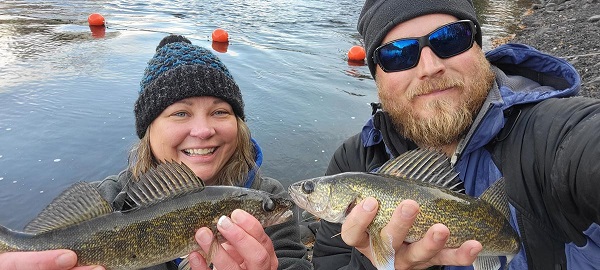
Above: Sabrina, Ben, and a couple of unidentified walleyes. Below: Rocky, Macy, and Petey
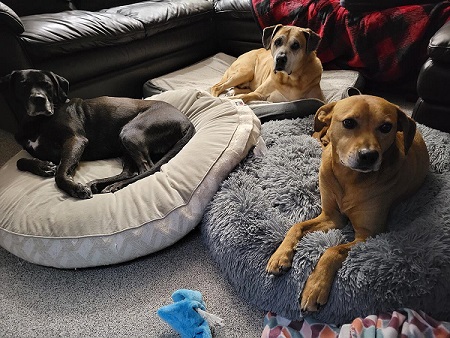
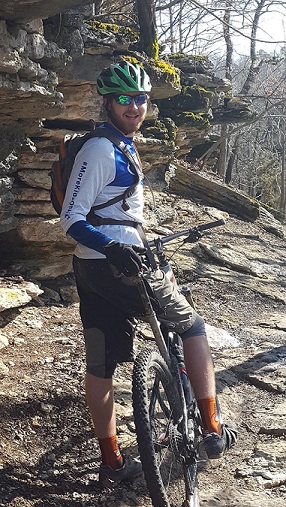 Jack Smude is an engineer aide, working on watermain plan review. He graduated from Dunwoody Institute of Technology with an engineering drafting degree.
Jack Smude is an engineer aide, working on watermain plan review. He graduated from Dunwoody Institute of Technology with an engineering drafting degree.
Jack grew up in Eagan and has two parents, Bob and Elise, one sister, Anne, one dog, Kona, and one cat, Ricky.
Jack works on weekends in the fall with the Minnesota Cycling Association, helping to set up the courses for high school bike races. His other hobbies are mountain biking, cross-country skiing, snowshoeing, fishing, and hunting. He hopes to get into fly fishing, winter camping, and any other outdoor activities and would really like to try ice climbing.

Sara Zentner is a communications fellow working on projects in source water protection. Her parents live in Madison, Wisconsin, with the family dog although since moving to Minnesota, Sara’s only pets are more house plants than she can count.
She moved to Minneapolis last fall to pursue a master’s degree in public health in environmental health with a focus on toxicology and risk assessment. She got her bachelor’s degree in biology with a certificate in environmental studies at the University of Wisconsin, Madison. While there, she worked at the School of Veterinary Medicine and as a research assistant with the U. S. Department of Agriculture.
Sara says, “Overall, I have a passion for the health of the natural world, including our ecosystems, animals, and making a difference in the lives of people. While pursuing my degree, I’ve gained a strong appreciation for Public Health and Environmental Justice relating to chemical exposures.”
Go to top
MDH Kiosk debuts at MRWA conference
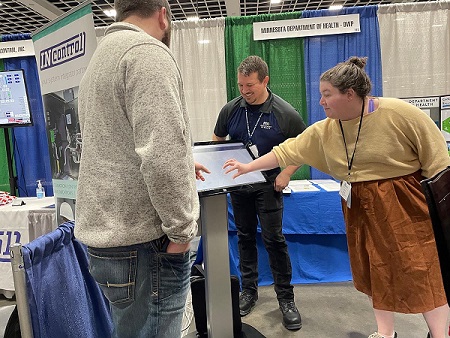
MDH had a kiosk at the Minnesota Rural Water Association conference in St. Cloud with an inventory mapping tool that allows utilities to view their lead service line inventories. MDH’s David Weum and Anna “A. J.” Schliep help an attendee navigate the tool.
The kiosk will also be available at the Minnesota Section of American Water Works Association conference in Duluth this fall from September 20 to 22. The Minnesota AWWA conference has been in Duluth since 2005 after rotating around the state in such hot spots as Moorhead, Detroit Lakes, St. Paul, and Mankato.
Go to top
Lead and drinking water testing program for school and child care programs
There is no safe level of lead. It is a neurotoxin that can cause permanent damage, with children being the most vulnerable. MDH offers a program for testing lead in drinking water in public schools, Head Start programs, and child care programs. This free program provides participants with sample kits, certified laboratory analysis, and technical assistance. .
Public water systems can share information about this program with schools and child cares in their service area using the information and flyers.
More information: Minnesota Lead Testing in Schools and Child Care in Drinking Water
Go to top
Lead service line inventories due October 16, 2024
As mandated by the federal Safe Drinking Water Act, all community and nontransient noncommunity water systems must prepare an inventory of all service lines (including those not in use) that are connected to water mains. These inventories, which are due to the Minnesota Department of Health by October 16, 2024, must include a location identifier and the material of the service line.
The first step in a process to remove lead service lines, the inventories will be regularly updated as additional information becomes available and as lead service lines are removed and replaced.
Go to top
Quote of the quarter
“It pays to agitate.” —From an article, “The Birth of a Nation,” in The Appeal (a St. Paul African American newspaper), October 30, 1915, page 3 (reprinted in “White Supremacy on Parade: The Fight to Stop Birth of a Nation in the Twin Cities,” by Drew M. Ross, Minnesota History, Spring 2023, pages 170-180).
Go to top
Did you know . . .
The 10 most common lake names in Minnesota are:
Mud
Long
Rice
Bass
Round
Horseshoe
Twin
Island
Johnson
Spring
Source: Minnesota Department of Natural Resources - Lakes, rivers, and wetlands facts
Go to top
Baseball wisdom
Mickey Mantle: “If I’d known I was going to live this long, I would have taken better care of myself.”
Casey Stengel on a 20-year-old prospect: “In 10 years, he has a chance to be 30.”
Go to top
Reminder to all water operators
When submitting water samples for analyses, remember to do the following:
- Take coliform samples on the distribution system, not at the wells or entry points.
- Write the Date Collected, Time Collected, and Collector’s Name on the lab form.
- Attach the label to each bottle (do not attach labels to the lab form).
- Include laboratory request forms with submitted samples.
- Do not use a rollerball or gel pen (the ink may run).
- Consult your monitoring plan(s) prior to collecting required compliance samples.
Notify your Minnesota Department of Health district engineer of any changes to your systems.
Go to top
Calendar
Operator training sponsored by the Minnesota Department of Health and Minnesota AWWA will be held in the coming months.
Register for schools and pay on-line:
Go to top